Nasa has recently released captivating images of a lunar landscape rarely observed by the Earthbound: the far side of the Moon.
This region, often mistakenly referred to as the “dark side,” is just as sunlit as the side facing Earth but remains an enigma due to its unique features and our inability to view it directly from our planet.
The far side of the Moon presents a starkly different appearance compared to the familiar near side. It is characterised by a rugged terrain replete with impact craters and a scarcity of maria-the expansive, dark plains formed by ancient volcanic activity.
These maria are less prevalent on the far side, making it resemble the barren surfaces of celestial bodies like Mercury or Callisto more closely.
This hidden hemisphere of the Moon has remained out of sight due to a phenomenon known as tidal locking.
The Moon’s rotational period is synchronised with its orbital period around Earth, causing the same lunar face to perpetually point toward us. As a result, the far side has been shrouded in mystery, only observable through space missions or satellite technology.
The intrigue surrounding the far side was heightened when the Soviet Luna 3 spacecraft first photographed it in 1959.
Since then, missions such as Nasa’s Lunar Reconnaissance Orbiter have provided further insights into this elusive region. Contrary to its nickname, the far side is not darker; it receives as much sunlight as the near side. However, its composition and cooling history differ, with the far side exhibiting more craters and an older surface.
Nasa’s recent image release offers a rare glimpse into this otherworldly terrain, sparking curiosity and wonder about the complexities of our celestial neighbor.


